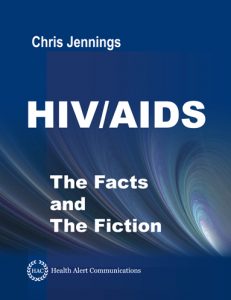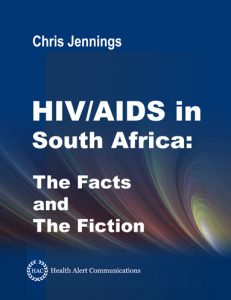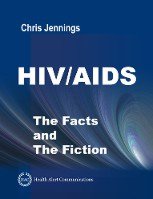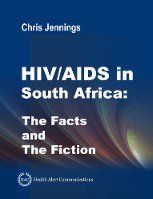 The situation with the African HIV / AIDS epidemic is analogous to that of the global finance crisis. Thousands of diligent people are investing money, effort, heart and soul into a false conceptual paradigm, while a small number of people aware of the situation are unconscionably reaping financial and professional rewards. Relative to HIV / AIDS, the false operative paradigm is that HIV / AIDS is devastatingly epidemic in Africa.
The situation with the African HIV / AIDS epidemic is analogous to that of the global finance crisis. Thousands of diligent people are investing money, effort, heart and soul into a false conceptual paradigm, while a small number of people aware of the situation are unconscionably reaping financial and professional rewards. Relative to HIV / AIDS, the false operative paradigm is that HIV / AIDS is devastatingly epidemic in Africa.
This false paradigm is causing the misdiagnosis of millions, who are taking drugs they don’t need, and precious public health resources are being misdirected away from the primary killers in the third world, namely, tuberculosis, pneumonias, and diarrheal illness (i.e., intestinal infections).
Overall, members of the pharmaceutical and diagnostic industries are both unwitting benefactors and risk-takers of this conceptual paradigm, but not its creators. Rather, the inflated estimates generated by computer models in Geneva are responsible along with decisions transpiring within political realms. Nevertheless, as the invalidity of this paradigm grows more evident, not only will income streams and the value of compounds diminish, industry will be unduly painted with blame, as they are the most visible recipients of revenues fed by philanthropy.
A full deconstruction of this paradigm is beyond the scope of this article. Rather, this article cursorily presents HIV / AIDS statistics belonging to the Republic of South Africa (RSA) and false assumptions input into the computer models that generated them.
The Republic of South Africa stands as the statistical exemplar for the HIV / AIDS situation in Africa, and perhaps in other tropical, indigent populations across the world as well. The RSA reportedly has the largest HIV / AIDS epidemic in the world [1].
Few people realize that the familiar HIV / AIDS global statistics are actually estimates. For example, UNAIDS estimated that the Republic of South Africa had 360,000 HIV/AIDS deaths in 1997 [2] However, after tabulating all death certificates for 1997, the Republic of South Africa attributed only 6,635 deaths to HIV / AIDS [3].
“…such prolonged longevity among the millions of indigent Africans purported to have HIV infection, in absence of effective treatment and / or prophylaxis, seems highly unlikely.”
One problem is that epidemiological models incorporate a misconception about the HIV incubation period. At the outset of the AIDS epidemic, the Centers for Disease Control (CDC) actively tracked and interviewed patients, and determined that HIV incubation averaged 8 to 18 months [4]. Danish physicians reported similar findings [5]. Fifty percent (50%) of these patients died within 12 months of manifesting opportunistic infection. Therefore, among adults, the first wave of AIDS deaths should occur 20 months after infection, not 10 years as currently conceived, thereby changing the distribution curve. Incubation among infants born with HIV infection was “several months.” Infant survival after birth averaged 9 months.
Once the scale of the epidemic moved beyond the feasibility of individual tracking and recording, investigators began modeling incubation, survival, and seroconversion rates among cohorts of gay men. However, these models are only partially based on raw data, they also incorporate estimated and imputed values [6–10]. Contrary to popular thought, there is no large database of raw empirical data detailing incubation for hundreds or thousands of patients. Rather, the incubation periods imputed into the computer models are estimates themselves.
The models applied by WHO / UNAIDS induct a 9–11 year survival period following HIV infection as mean. Such longevity might be feasible for patients receiving effective treatment and / or prophylaxis for HIV infection and / or its consequent opportunistic infections, even prior to the implementation of HAART. However, such prolonged longevity among the millions of indigent Africans purported to have HIV infection, in absence of effective treatment and / or prophylaxis, seems highly unlikely.
“Contrary to popular thought, there is no large database of raw empirical data detailing incubation for hundreds or thousands of patients.”
For example, prior to 1985, AIDS patients in the United States lacked effective therapeutic and / or prophylactic drug regimens versus HIV infection and / or its consequent opportunistic infections. In these populations, 50% of AIDS patients died within 12 months of opportunistic disease manifestation.11 Between June 1981 and August 1983, the first two years of the AIDS epidemic, 38% of all diagnosed AIDS patients had died, and 71% of all AIDS patients diagnosed more than a year prior to August 1983.12
Therefore, in the Republic of South Africa, one should expect comparable patient outcomes, particularly since the greater majority of the millions of indigent Africans purported to have HIV infection lack access to effective therapeutic and / or prophylactic drug regimens.
Given 2,900,000 South Africans with HIV infection in 1998 (per UNAIDS estimate), at least 1.1 million (38%) or so should have died by the end of 2002. The period from 1998 to 2002 is four years – allowing for a 2-year incubation period before the development of opportunistic infections. Once opportunistic diseases have appeared, approximately 38% of these AIDS patients should have died in the following 2-year period. Even allowing a mean 11-year survival period, the upper level inducted into the computer models, a substantial cluster of these people should have died by 2008. Yet, the RSA tabulated a total of 136,000 HIV/AIDS deaths for 1997 – 2008, inclusive.
First Published in PharmaPhorum
- HIV / AIDS The Facts And The Fiction
- HIV / AIDS in South Africa: The Facts and The Fiction
References
[1] UNAIDS. Global report: UNAIDS report on the global AIDS epidemic 2010. Geneva, Switzerland 2010. [FREE Full Text]
[2] UNAIDS/WHO. Report on the global HIV/AIDS epidemic – June 1998. Geneva, Switzerland June 1998. [FREE Full Text]
[3] Mortality and causes of death in South Africa, 2003 and 2004 Findings from death notification. In: Africa SS, ed. Pretoria, South Africa: Statistics South Africa, 2006. [FREE Full Text]
[4] CDC. The safety of hepatitis B virus vaccine. MMWR Morb Mortal Wkly Rep. Mar 18 1983,32(10):134-136. [PMID: 6405154] [FREE Full Text]
[5] Gerstoft J, Nielsen JO, Dickmeiss E, Ronne T, Platz P, Mathiesen L. The acquired immunodeficiency syndrome (AIDS) in Denmark. A report from the Copenhagen study group of AIDS on the first 20 Danish patients. Acta Med Scand. 1985,217(2):213-224. [PMID: 3993435]
[6] Jacobson LP, Kirby AJ, Polk S, et al. Changes in survival after acquired immunodeficiency syndrome (AIDS): 1984-1991. Am J Epidemiol. Dec 1 1993,138(11):952-964. [PMID: 7903022]
[7] Lui KJ, Lawrence DN, Morgan WM, Peterman TA, Haverkos HW, Bregman DJ. A model-based approach for estimating the mean incubation period of transfusion-associated acquired immunodeficiency syndrome. Proc Natl Acad Sci U S A. May 1986. [PMID: 3458163]
[8] Lui KJ, Darrow WW, Rutherford GW, 3rd. A model-based estimate of the mean incubation period for AIDS in homosexual men. Science. Jun 3 1988,240(4857):1333-1335. [PMID: 3163848]
[9] Muñoz A, Wang MC, Bass S, et al. Acquired immunodeficiency syndrome (AIDS)-free time after human immunodeficiency virus type 1 (HIV-1) seroconversion in homosexual men. Multicenter AIDS Cohort Study Group. Am J Epidemiol. Sep 1989,130(3):530-539. [PMID: 2669471]
[10] Jaffe HW, Darrow WW, Echenberg DF, et al. The acquired immunodeficiency syndrome in a cohort of homosexual men. A six-year follow-up study. Ann Intern Med. Aug 1985,103(2):210-214. [PMID: 2990275]
[11] Harris JE. Improved short-term survival of AIDS patients initially diagnosed with Pneumocystis carinii pneumonia, 1984 through 1987. JAMA. Jan 19 1990,263(3):397-401. [PMID: 2294306]
[12] CDC. Current Trends Prevention of Acquired Immune Deficiency Syndrome (AIDS): Report of Inter-Agency Recommendations MMWR Morb Mortal Wkly Rep. March 04, 1983 1983,32(8):101-103. [PMID: 6403825] [FREE Full Text]
About the author:
Chris Jennings is an independent HIV/AIDS Analyst, and medical writer serving the pharmaceutical, diagnostic, and analytical industries. Relative to HIV/AIDS, he served as a Preferred Vendor to Bayer Diagnostics, Bayer Healthcare LLC (Tarrytown, NY), and has composed HIV assay specification sheets, written about the juxtaposition of the HIV assay in the diagnosis and clinical management of HIV infection, and assay architecture. For pharmaceutical clients, he composed clinical trial reports for several antiretrovirals and compounds versus opportunistic infections. He also wrote and published 2 trade books on HIV/AIDS that were adopted as educational texts by world-renowned hospitals, federal, state, and municipal health agencies, and nursing schools, public health schools, and universities.






Leave a Reply